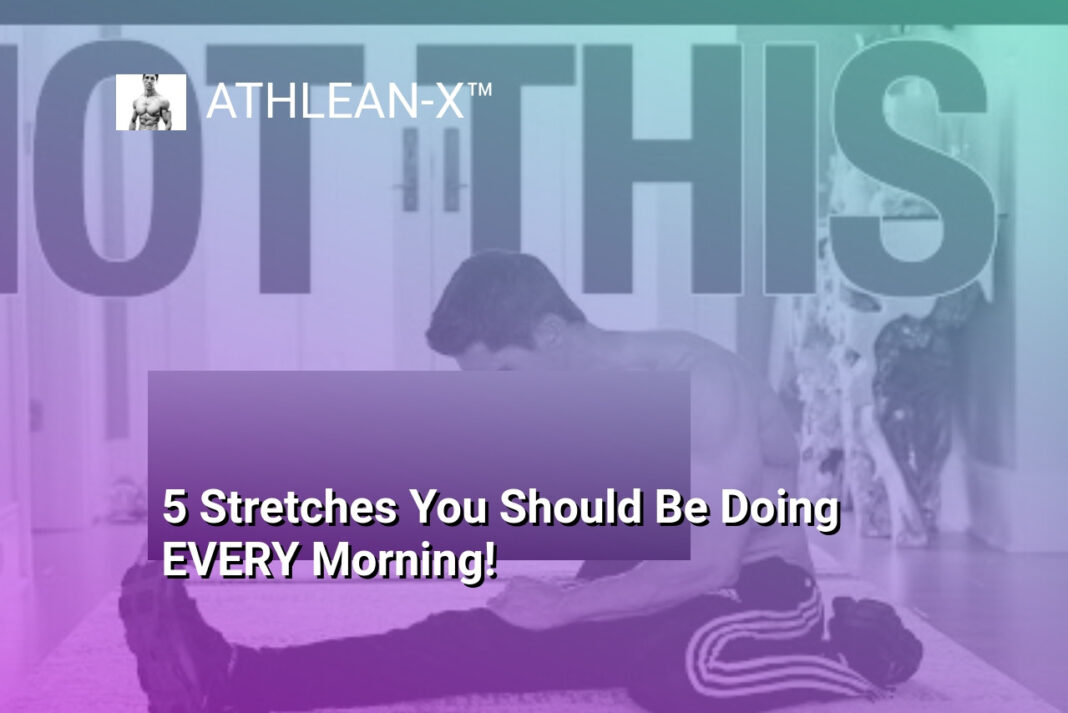The Bottom Line:
- Performing a simple 5-exercise morning routine can significantly improve your daily energy and well-being, potentially making you feel years younger.
- The routine includes exercises like the bridge and reach, side rotations, deep squats, hip flexor stretches, and hamstring stretches, all designed to target areas that often become tight and restricted from daily activities.
- Each exercise takes just 3-4 minutes to complete, but the cumulative benefits of doing this routine consistently every morning can be transformative.
- The exercises focus on improving mobility, flexibility, and activation in key muscle groups, helping to alleviate common issues like low back pain and stiffness.
- For those looking for a more comprehensive program that includes both stretching and strength training, the author recommends checking out the resources available at aex.com.
The Bridge and Reach
Unlocking Mobility and Flexibility
The bridge and reach exercise is a powerful way to kickstart your morning routine. By bridging up and reaching across your body, you activate your glutes and get some much-needed rotation through the upper spine. This not only helps wake up your body, but also targets areas that often become tight and restricted due to our sedentary lifestyles.
Addressing Lower Back Tightness
Next, we focus on the quadratus lumborum (QL), a muscle that can contribute to lower back pain and tightness. By dropping one hip to the side and reaching for the opposite foot, you’ll feel a deep stretch in this often-neglected area. This simple exercise can provide significant relief and improved mobility in the lower back region.
Enhancing Thoracic Rotation
The deep squat with rotation is a game-changer. By placing your hands on the ground between your heels and driving your elbows into your thighs, you create a stable base that allows you to explore a full range of thoracic rotation. This not only stretches the hips and groin, but also targets the thoracic spine, an area that often lacks sufficient mobility and flexibility.
By incorporating these targeted exercises into your morning routine, you’ll unlock a new level of mobility and flexibility, setting the stage for a more energized and youthful day ahead. Remember, consistency is key – the more you make this routine a habit, the more you’ll feel the cumulative benefits over time.
Targeting the Quadratus Lumborum
Targeting the Quadratus Lumborum
We now focus on an area of the low back that many people complain of tightness and pain – the quadratus lumborum (QL). This muscle can get really tight and actually hike up the hip a little on that side. To target the QL, get into a position where your palms are down on the floor. Drop one leg back, landing on that hip. Reach as far as you can towards the back foot, using the floor to push and stretch this area. Repeat on the other side, allowing your body to rotate until the hips touch the ground. You’ll feel the stretch in the QL region right above the hip. Hold each side for 10-15 seconds and repeat 2-3 times.
Enhancing Thoracic Rotation
From here, we’ll move into a deep squat position, with your hands placed flat on the ground between your heels. Drive your elbows into your thighs, which will help open up the groin area. Now, take one arm up and reach as high as you can, using the elbow to drive into the thigh and post off, allowing you to go deeper into the rotation. Repeat on the other side, focusing on getting that thoracic spine to open up and rotate.
Addressing the Hip Flexors
Next, we’ll target the hip flexors, which can get very tight from prolonged sitting. Get into a deep lunge position, dropping the back knee down and stretching out the front hip flexor. Then, take your hands up overhead and rotate around the forward knee, sinking deeper into the stretch and opening up the thoracic spine even further. Repeat on the other side, focusing on maximizing the range of motion in this area.
Deep Squat with Thoracic Rotation
Enhancing Mobility and Rotation
The deep squat with thoracic rotation is a powerful exercise that targets multiple areas of the body, promoting improved mobility and flexibility. This movement not only challenges the hips and groin but also emphasizes the importance of thoracic spine rotation, an often-neglected aspect of overall spinal health.
Unlocking Thoracic Mobility
Begin by assuming a deep squat position, with your feet flat on the floor and your elbows driving into your thighs. This stance not only stretches the adductors but also sets the stage for the thoracic rotation. Keeping one elbow firmly planted, reach the opposite arm up and overhead, focusing on rotating the thoracic spine as far as possible. Repeat this motion on the other side, alternating between left and right. The key is to maintain the deep squat position while allowing the thoracic spine to freely rotate, unlocking stiffness and improving overall spinal mobility.
Enhancing Functional Movement
The deep squat with thoracic rotation is not only a valuable mobility exercise but also has practical applications in daily life and athletic endeavors. By improving the range of motion in the thoracic spine, this movement enhances the body’s ability to perform functional tasks, such as reaching, twisting, and bending, with greater ease and efficiency. Incorporating this exercise into your morning routine can help prepare your body for the demands of the day, reducing the risk of injury and promoting overall well-being.
Releasing the Hip Flexors
Unlocking the Power of the Hip Flexors
The hip flexors play a crucial role in our daily movements, yet they are often overlooked and neglected. Tight hip flexors can lead to a host of issues, including lower back pain, poor posture, and restricted mobility. In this section, we’ll explore a series of targeted exercises that will help you release and revitalize these essential muscles.
Lunge and Rotate
Begin by getting into a deep lunge position, with your front knee at a 90-degree angle and your back knee almost touching the ground. Engage your core and reach your arms overhead, then rotate your torso towards the front leg. This movement not only stretches the hip flexor but also incorporates a twist, which helps to increase mobility in the thoracic spine.
Kneeling Hip Flexor Stretch
From the lunge position, transition into a kneeling stance. Keeping your front knee at a 90-degree angle, sink your hips back and down, feeling the stretch in the front of your hip. To deepen the stretch, you can gently lean your torso forward while maintaining a neutral spine.
Remember to repeat these exercises on both sides, holding each stretch for 10-15 seconds and completing 2-3 sets per side. By incorporating these hip flexor-targeting movements into your morning routine, you’ll unlock greater flexibility, improved posture, and a renewed sense of energy to start your day.
Hamstring Stretching
Hamstring Stretching
One area we really haven’t addressed yet is the hamstrings. People often say they’re going to stretch them out by bending forward, but that’s not the most effective way to target the hamstrings. When you go into a posterior pelvic tilt, you’re taking the tension off the hamstrings and focusing more on other muscles.
Instead, we want to get into the hamstrings by maintaining an anterior pelvic tilt. To do this, start by placing your hands behind you, creating an arch in your lower back. Keep your chest open and high, then sink your hips back, feeling the stretch through the back of your legs and into your hamstrings. It’s important not to bend forward from here, as that can reduce the effectiveness of the stretch.
You can do this stretch for 10-15 seconds, going down into the bottom position and really focusing on keeping that anterior tilt. This not only helps target the hamstrings, but it also reinforces proper hip hinge mechanics, which can be beneficial if you’re doing exercises like deadlifts or bent-over rows in your training.
Engaging the Glutes
Another key aspect of this morning routine is the bridge and reach exercise, which helps activate the glutes. Start by lying on your back with your knees bent and feet flat on the floor. Lift your hips up, engaging your glutes, and then reach your arm across your body, towards the opposite shoulder. This not only works the glutes, but also introduces some rotation through the upper spine, which is an area many people lack mobility in.
Perform 5-6 repetitions on each side, really focusing on squeezing the glutes as you bridge up. This is a great way to wake up those important muscle groups and get them firing properly to start your day.
Addressing Tight Quadratus Lumborum
Another common area of tightness that this routine addresses is the quadratus lumborum (QL), which can contribute to low back pain. To target this muscle, start by sitting up and placing your palms on the floor. Drop one hip back, rotating your body until your hip touches the ground. Reach your arm towards the back foot, feeling the stretch along the side of your back.
Repeat this on the other side, holding each stretch for 10-15 seconds. The QL can get very tight, especially in those who sit for long periods, so addressing this area can help alleviate low back discomfort.
By incorporating these hamstring, glute, and QL stretches into your morning routine, you’ll be setting yourself up for a more energized and revitalized start to your day. Remember to take your time with each exercise, focusing on proper form and technique to get the most benefit from this quick, yet impactful, 5-minute routine.





